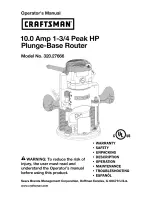
xStack DES-3800 Series Layer 3 Stackable Fast Ethernet Managed Switch
The following parameters can be set:
Parameter Description
STP Status
Use the pull-down menu to enable or disable STP globally on the Switch. The default is
Disabled
.
STP Version
Use the pull-down menu to choose the desired version of STP to be implemented on the Switch.
There are two choices:
STPCompatability
- Select this parameter to set the Spanning Tree Protocol (STP) globally on the
switch.
RSTP
- Select this parameter to set the Rapid Spanning Tree Protocol (RSTP) globally on the
Switch.
MSTP
- Select this parameter to set the Multiple Spanning Tree Protocol (MSTP) globally on the
Switch.
Hello Time
The
Hello Time
can be set from 1 to 10 seconds. This is the interval between two transmissions
of BPDU packets sent by the Root Bridge to tell all other switches that it is indeed the Root
Bridge. This field will only appear here when STP or RSTP is selected for the STP Version. For
MSTP, the Hello Time must be set on a port per port basis. See the
STP Port Settings
section
for further details.
Max Age
The
Max Age
may be set to ensure that old information does not endlessly circulate through
redundant paths in the network, preventing the effective propagation of the new information. Set
by the Root Bridge, this value will aid in determining that the Switch has spanning tree
configuration values consistent with other devices on the bridged LAN. If the value ages out and a
BPDU has still not been received from the Root Bridge, the Switch will start sending its own
BPDU to all other switches for permission to become the Root Bridge. If it turns out that your
switch has the lowest Bridge Identifier, it will become the Root Bridge. The user may choose a
time between 6 and 40 seconds. The default value is 20.
Forward Delay
The
Forward Delay
can be from 4 to 30 seconds. Any port on the Switch spends this time in the
listening state while moving from the blocking state to the forwarding state.
Max Hops
Used to set the number of hops between devices in a spanning tree region before the BPDU
(bridge protocol data unit) packet sent by the Switch will be discarded. Each switch on the hop
count will reduce the hop count by one until the value reaches zero. The Switch will then discard
the BDPU packet and the information held for the port will age out. The user may set a hop count
from 1 to 20. The default is 20.
Default Path
Cost
This read-only field displays the protocol used in determining the default path cost per port.
802.1T
will calculate this 32-bit cost value through the use of a specific formula based on the port
bandwidth.
TX Hold Count
Used to set the maximum number of Hello packets transmitted per interval. The count can be
specified from 1 to 10. The default is 3.
Forwarding
BPDU
This field can be
Enabled
or
Disabled.
When
Enabled,
it allows the forwarding of STP BPDU
packets from other network devices. The default is Enabled.
Loopback
Detection
This feature is used to temporarily shutdown a port on the Switch when a BPDU packet has been
looped back to the switch. When the Switch detects its own BPDU packet coming back, it signifies
a loop on the network. STP will automatically be blocked and an alert will be sent to the
administrator. The LBD STP port will restart (change to discarding state) when the
LBD Recover
Time
times out. The Loopback Detection function will only be implemented on one port at a time.
The user may enable or disable this function using the pull-down menu. The default is Enabled.
LBD Recover
Time
This field will set the time the STP port will wait before recovering the STP state set. 0 will denote
that the LBD will never time out or restart until the administrator personally changes it. The user
may also set a time between 60 and 1000000 seconds. The default is 60 seconds.
Click
Apply
to implement changes made.
93
Summary of Contents for xStack DES-3800 Series
Page 50: ...xStack DES 3800 Series Layer 3 Stackable Fast Ethernet Managed Switch 35 ...
Page 340: ......
Page 357: ......
Page 360: ......
















































